How to Attend Our Upcoming Garden Open House (& a Virtual Tour)
Our garden open house (rain or shine) is THIS coming Saturday!
APPALACHIAN FEET GARDEN OPEN HOUSE DETAILS:
Drop-in June 14th, 9:00am – 5:00pm
Recommended donation of $2-$5
440 Summit Drive, Greenville, SC
You may also want to catch Eliza’s TEDx presentation at Zen on Tuesday, June 17th at 5:30pm. Additionally, Eliza wrote the feature article (on pawpaws) in the latest Edible Upcountry magazine, available for free at area locations like the Swamp Rabbit Cafe & Grocery, The Carolina Honeybee Company, or The Community Tap.
Our plans for the garden open house are not as far along as we expected at this point — partly due to Eliza’s busy speaking and landscape consulting schedule this past spring, but mainly due to another pregnancy and recurrent miscarriage. Last Monday we went to a first trimester appointment and Eliza began miscarrying during the ultrasound. We decided to mention it because miscarriages are so common and so rarely talked about (1 in 4 pregnancies ends in miscarriage). It would be nice if society was a little better informed. We’re doing better this time around but appreciate all the optimistic sympathy we’ve received.
Here’s what we know for sure will be available to view at the garden open house (June 14th, 9:00am-5:00pm):
- A Q&A tent where Eliza & Nathaniel will answer your questions (& likely refreshment stand)
- Lawn-free edible landscaping, especially in the front yard, featuring guilds, microclimates, and hundreds of plant species
- Unusual perennial food crops for the southeast
- Lots of hugelkultur examples
- Keyhole bed design
- Sheet mulching/deep mulching & soil ecology
- Water catchment swales in pathways
- Edible mushroom farming
- Pallet gardens
- Farmscaping (Thorough organic pest control through attracting a complete ecosystem)
- Chickens, chicken coop, & run (which contains a hawk deterring “fedge” — aka food hedge)
- Black soldier fly waste composting and chicken feed
- Worm bin composting
- Cold composting
- Live fermentation and canning displays
- Seed saving display
- Mildly grouchy honeybees that occasionally send a lone guard to chase us around — we’ll let you view the apiary from a distance (or you can just stay in the front yard if you feel concerned). We’ll be requeening our hives with more peaceful stock soon.
- The beginnings of our first pond (under construction)
- The beginnings of our duck run (under construction, no ducks yet)
- Part of an herb spiral (we may finish it before this weekend)
- Our personal micro-nursery
- A 5th generation (for our family) passalong pomegranate tree in full bloom
- Detailed plans about our eventual goals for the property and the chance to see it in progress
We may add a little bit more to the list before Saturday if health and time permit. Here’s a sneak peak at the front yard garden, which is the only thing that is nearly finished:
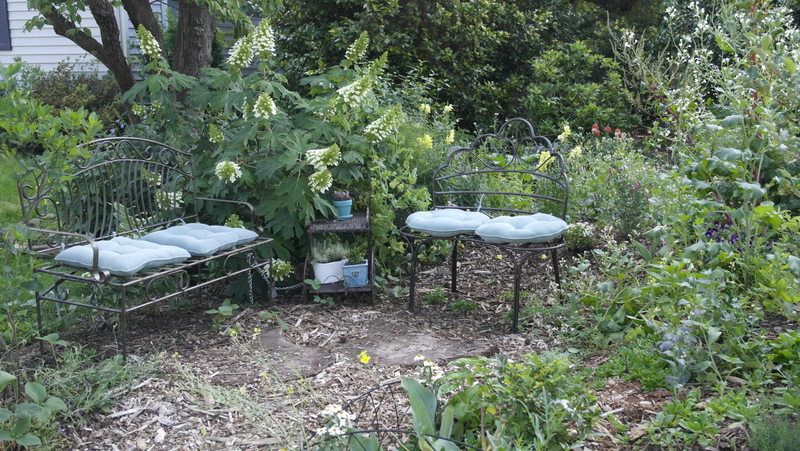
Photo Caption: Eliza planned to have a neighbor-friendly sitting area near the sidewalk for years… it’s nearly finished! The benches are a popular sitting area for parents picking up kids from next door Summit Elementary.
We are so happy with our front hugelkultur beds! Eliza has had to water a lot due to adding many new seeds and plants (you have to keep them watered until their roots reach deep down into the composting wood reservoir). However, the plants we established last year are utterly drought-proof. They’re also expressing their approval of hugeling by growing absurdly large — one bed has a Phlox paniculata ‘David’ that is already 6′ tall and does not appear to be stopping any time soon.
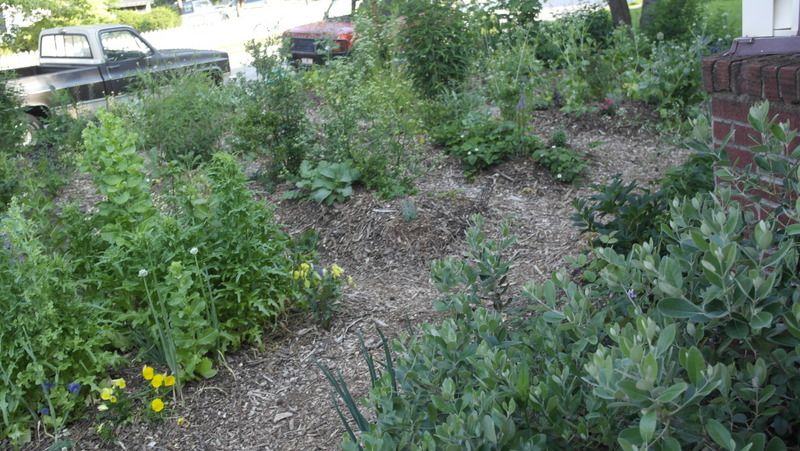
Photo Caption: It is difficult to photograph the shapes of the beds, but it is a permaculture keyhole pattern that has been completely hugelkultured underneath.
You may remember the above garden view from this process photo post when we were adding the hugels last year. Here is what it looks like a year later — still not completely mature but everything is filling in nicely.

Photo Caption: The flowers of these tuberous begonias and small violas are edible… and so is the fern! Eliza has been trying to grow ostrich ferns for their fiddleheads ever since she bought the house. Hugelkultur saves the day, again — they’re taking over!
We knew hugelkultur was reputed to be nature’s irrigation system, but we couldn’t believe how much easier it made growing finicky plants like ostrich ferns, rhubarb, and gooseberries.
We like to choose edible species that are also ornamental.
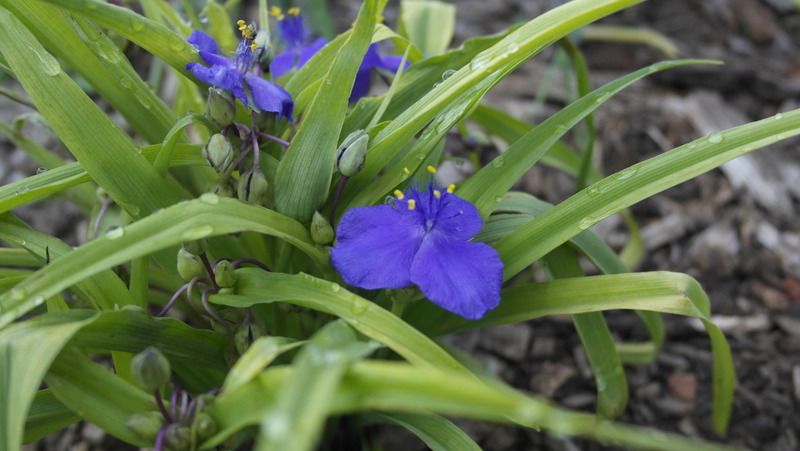
Photo Caption: Tradescantia ‘Sweet Kate’ has all the edibility and bumblebee attractiveness of a spiderwort with head-turning chartreuse foliage and cobalt flowers.
Ever consider eating our native spiderworts? Here’s how.
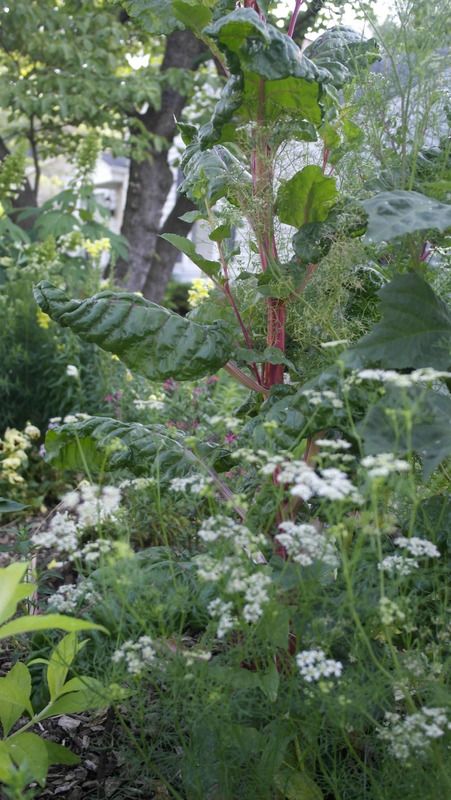
Photo Caption: Passerby asked if this tall red plant was poke sallet, but it is a bolting ruby-stemmed Swiss chard. In the foreground is the ‘Delfino’ cilantro we save seeds from every year.
The overwhelming majority of neighbors who stop to chat about our garden are very complimentary. A few days after these photos were taken we did have one woman inform us that we have a lot of weeds… guess the cottage garden look isn’t for everyone! Perhaps it was a misunderstanding since we grow so many species she may not recognize. Eliza wanted to ask which plants she thought were weeds but the lady crossed to the other side of the street on her way back past our house.
Usually we get questions about specific plants and people wanting to know how to do similar gardens in their own yard. Eliza was gratified a few days ago when she overheard a Spanish-speaking man point to the edible opuntia cactus near the road and excitedly say, “Nopales!” to his friend.

Photo Caption: Eliza is trying to finally get around to adding some aesthetic accents to the garden… it’s so easy to get distracted by practicalities!
We consider beauty to have its own uses in the garden and not everything we grow is there for us to harvest. We’ve enjoyed the recent addition of some benches, a tea cart, potted plants and other small hardscaping elements.

Photo Caption: Sky blue accents set off the cool-colored front yard beds. In the background is ‘Redventure’ celery, a red-stemmed celery that grows great in the winter. Since it is bolting, we’re saving seeds.
The garden is constantly changing, partly because we are often letting food plants go to seed. The honeybees worked our flowering brassicas like kale, turnips, collards, arugula, and radishes hard during the spring. Eventually we replaced them with summer plantings (usually when they start smothering their neighbors or finishing their life cycles).
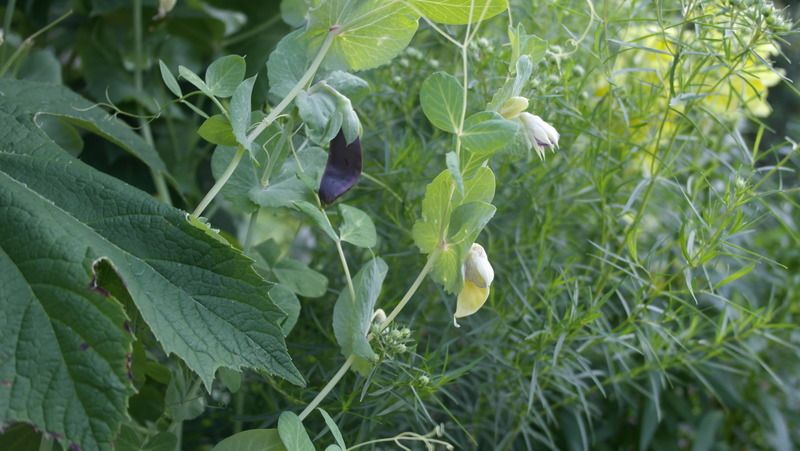
Photo Caption: Blue and golden podded sugary peas have provided a nice cool season snack next to the garden benches. In the summer we’re replacing them with ‘White Currant’ tomatoes.
Sometimes we use our perennials as makeshift trellies — snow and sugar snap peas obliged us by climbing our native oakleaf hydrangea and redbud tree.
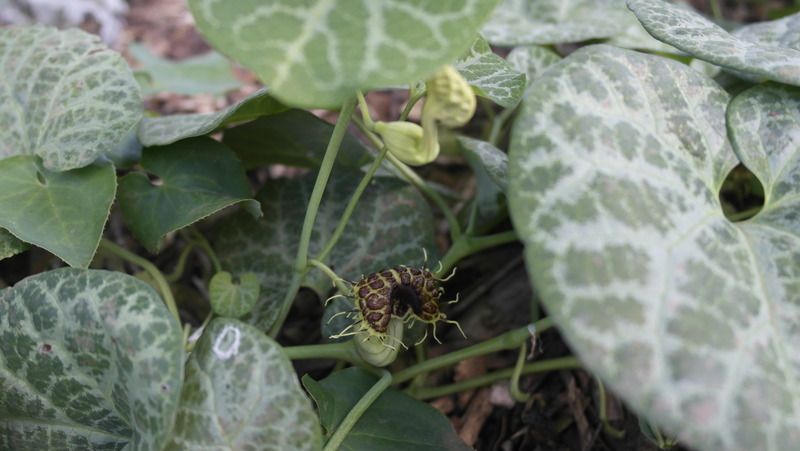
Photo Caption: Keep an eye out for these little dutchman’s pipes blooming right now in our front yard. In the mid-summer we find them covered in adorable gummy-bear like caterpillars that turn into stunning pipevine swallowtail butterflies.
Other plants are there for the bugs. When we want specific insects to help balance out the garden we use farmscaping techniques by finding out what they prefer to eat and planting it. Insect pest control has never been less work!
We’re still thankful to Anna and Mark at The Walden Effect for giving us our now fully established black raspberries, red raspberries, and thornless blackberries. So far not a single berry has made it into the house.
Our brambles (raspberries and blackberries) line the driveway between a cinderblock wall and a barricade of straw bales. We like how the berries fill in between these 2 barriers and blocks all the light (and thus weeds) that grow underneath them.
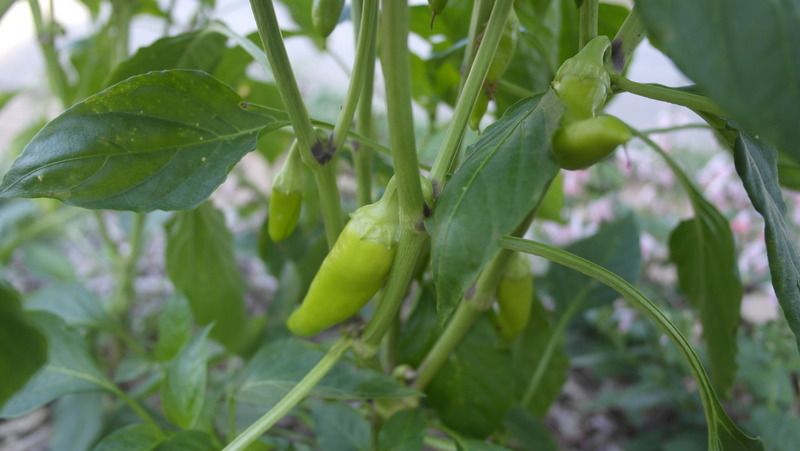
Photo Caption: We’re already harvesting ‘Sweet Banana’ peppers and small eggplants, but we were late getting the tomatoes in and have a ways to wait still on those.
During Eliza’s pregnancy she wasn’t allowed to dig new beds. As a result, she started triaging all the vegetable starts by sticking them anywhere there was enough light and space in a pre-prepared bed.
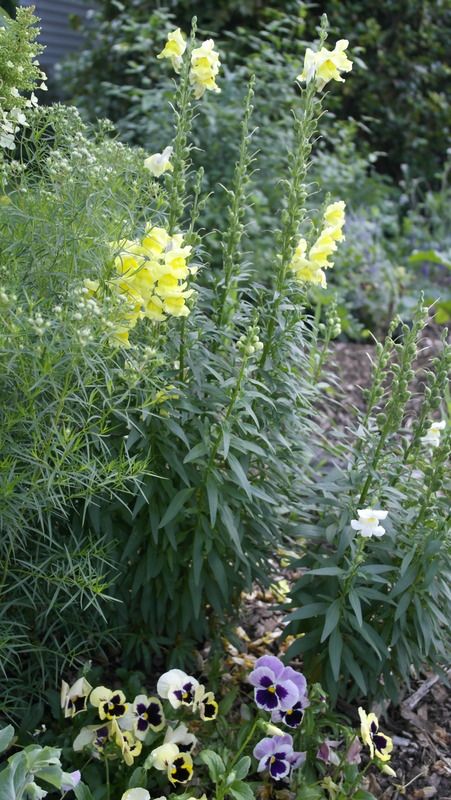
Photo Caption: Flowers are interspersed among the edible plants for beauty, beneficial insect nectaries, and occasionally even have yummy blooms.
Tall flowering plants like snapdragons, veronicas, foxgloves, agastaches, salvias, and penstemons add structure to the garden and food for beneficial insects.
Eliza has been trying to relocate any orange and red flowering plants to the backyard in order to maintain a cool color scheme. There’s some stragglers but she’s getting close to reaching that goal.
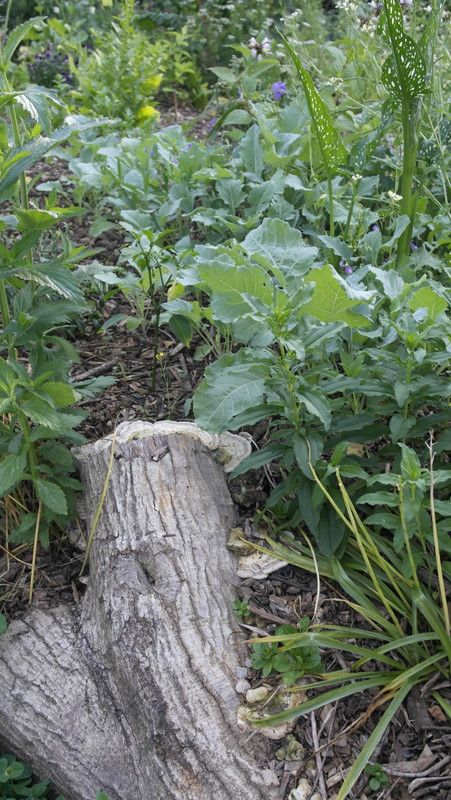
Photo Caption: Our log retaining wall has started sprouting mushrooms. In the background is kohlrabi and a head-turning plant called a ‘Green Goddess’ calla.
In order to keep soil off the sidewalk, we used the most inexpensive material we could think of for a retaining wall — our neighbor’s discarded logs and woody debris. Some of it is quite sculptural and a few even have edible oyster mushrooms that fruit from them. The mushrooms pictured above are not a culinary variety.

Photo Caption: The garden is only 2 years old but is already starting to look somewhat mature due to the speed plants grow in hugel beds.
The plants will continue to fill in and help define the keyhole pattern of our beds vs. our mulched pathways.

Photo Caption: Some people love our white clover edging that provides a unifying deep green border, honeybee blooms, and soil fertility building nitrogen-fixing. Others don’t know that clover is a popular lawn alternative and ask if we planted it on purpose.
Since we don’t have a lawn it was never convenient to haul out a lawnmower for the grassy verge between the sidewalk and the road. Last fall we replaced it with white clover so that we only have to weed. We bookended either end with comfrey — a great weed barrier so our neighbor won’t have to keep clover out of his grass and vice versa.
We love to use native plants whenever possible. The dozens of species in our front yard includes mountain mint, sedum, hearts-a-bustin’, oakleaf hydrangea, clethra, piedmont azalea, northern river oats, woodland phlox, jack-in-the-pulpit, coreopsis, and pawpaw trees — our largest native fruit.

Photo Caption: If our landscaping plants aren’t edible they have other uses that support the overall garden ecology.
We also use a variety of exotic species that do not show aggressive tendencies.
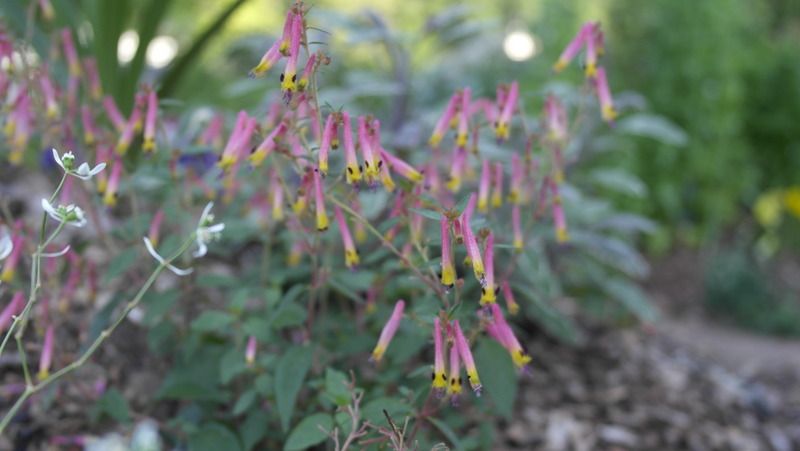
Photo Caption: Cuphea are popular with beneficial insects and hummingbirds — they also look like adorable little fairy pets!
Eliza likes to find at least one new-to-her plant each season. She’d never seen pink cuphea before.
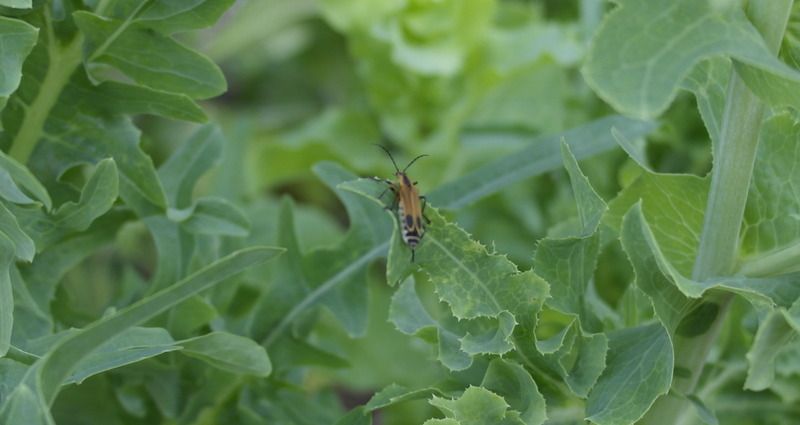
Photo Caption: This predatory soldier beetle is hanging out on some bolting lettuce. We love having it and similar species around because it means we rarely have to do anything about pest control.
We decided not to let our lettuce go to seed in the front yard because it looks like a weed to many people. We’re letting it and other unruly looking plants bloom and produce seed in the backyard instead.
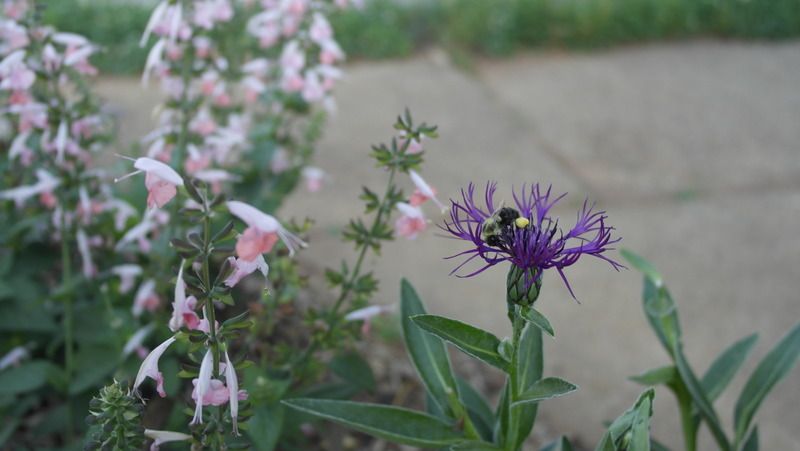
Photo Caption: Though bumblebees are dying out in many parts of the country, they are thriving in our heavily blooming garden.
Many people never stop and really see a garden. We hope ours will turn some heads.

Photo Caption: Comfrey is an incredible nutrient accumulating plant that also has edible flowers, excellent honeybee nectar, and medicinal uses.
Sterile comfrey is well used in our landscape with some borders and individual plantings. It’s amazing how fast it grows and how great it is as a chop and drop fertilizer plant.
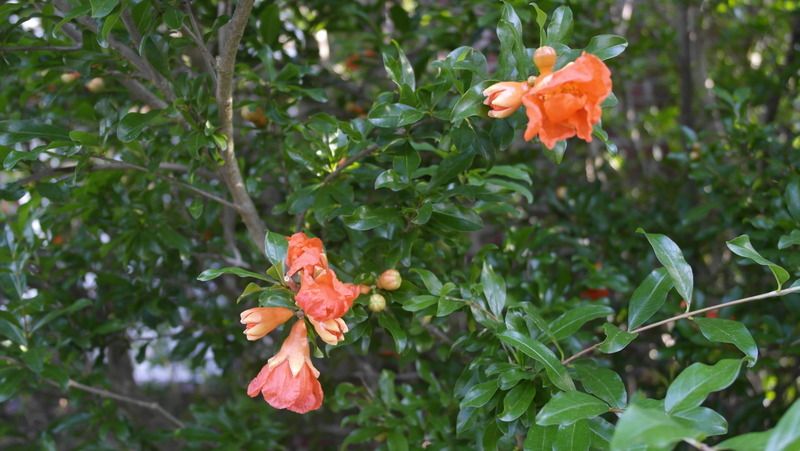
Photo Caption: You just have to see our pomegranate right now, it’s enormous and the blooms will make your mouth hang open.
If any of this has piqued your interest we’d love to see you at the garden open house this coming Saturday, bring a friend!
APPALACHIAN FEET GARDEN OPEN HOUSE DETAILS:
Drop-in June 14th, 9:00am – 5:00pm
Recommended donation of $2-$5
440 Summit Drive, Greenville, SC
3 thoughts on “How to Attend Our Upcoming Garden Open House (& a Virtual Tour)”
Comments are closed.
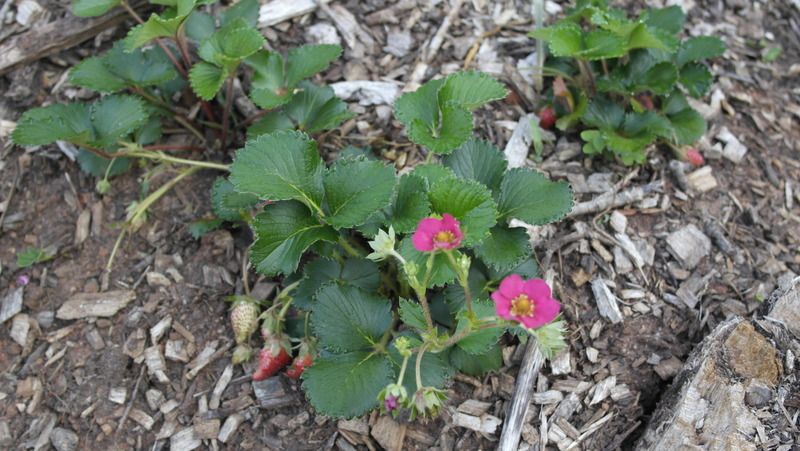
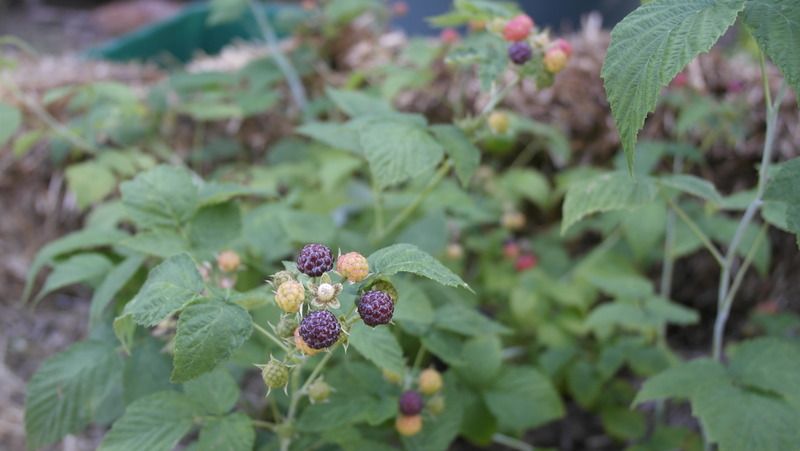

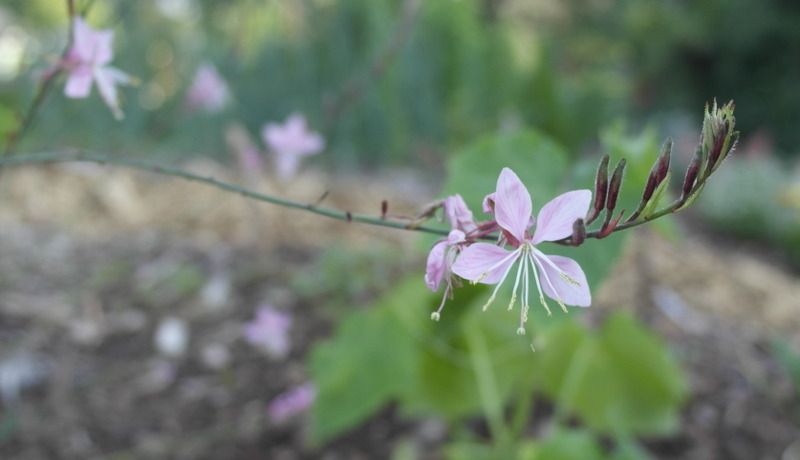
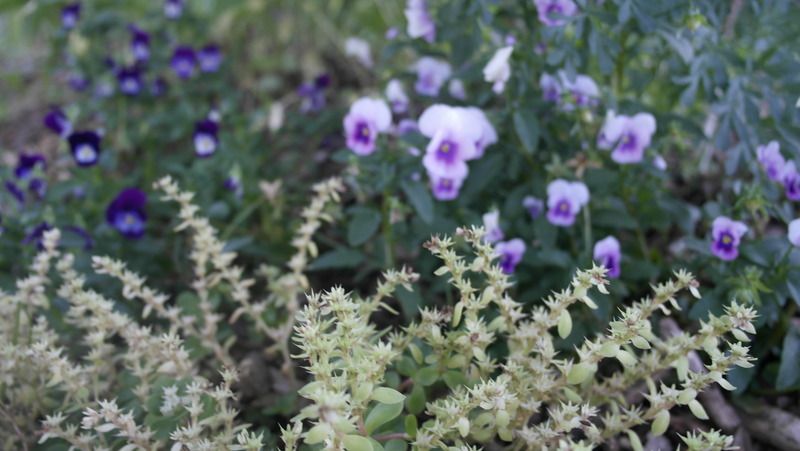

Mark Willis
Twitter: marksvegplot
- June 10, 2014 1:41 am
I wish I lived near you so that I could attend your Open Garden event, but this post provides a lot of information anyway. I was very interested to see the results of your hugelkultur work. It seems to have been a HUGE success (excuse the pun)! Also fascinating to see how everything in your garden has a purpose, and is not just for ornament. Hope the sun shines for you on Saturday, and that you get lots of visitors!
Mark Willis´s last blog post ..Harvest Monday – 9th June 2014
Malcolm and Carole Gibson - June 12, 2014 3:57 pm
We are so sorry to hear of your loss. We are looking forward to seeing you at your open house this Saturday.
Liene - June 16, 2014 9:46 am
Thank you very much for the tour of your garden, as well as so patiently answering my questions!
Liene´s last blog post ..What is permaculture?